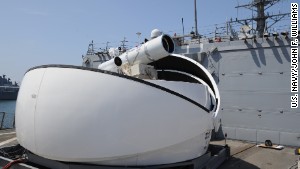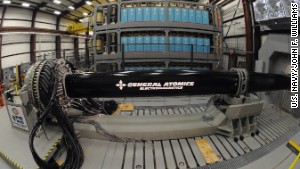| 美海军的未来发展方向已经确定。 | ||
| 送交者: SDUSA 2014年04月12日08:53:08 于 [军事天地] 发送悄悄话 | ||
Navy's future: Electric guns, lasers, water as fuel
STORY HIGHLIGHTS
(CNN) -- Imagine ships that fire missiles at seven times the speed of sound without using explosives, or that use lasers to destroy threats at the cost of about a dollar a shot, and vessels making fuel from the very seawater in which they're floating. That's the glimpse of the high-tech future the U.S. Navy gave this week. And these aren't just ideas. They've all been shown to work to some degree. Saturday, the Navy will christen its most advanced warship ever, the destroyer USS Zumwalt, which may one day be using these new technologies. The Zumwalt, which was launched last year and is to be christened at Bath Iron Works in Maine, is the Navy's first stealth destroyer. At 610 feet long and 80 feet wide, it's about 100 feet longer and 20 feet wider than ships in the Navy's current fleet of Arleigh Burke class destroyers, but the canopy and the rest of the Zumwalt is built on angles that help make it 50 times harder to spot on radar than an ordinary destroyer. "It has the radar cross-section of a fishing boat," Chris Johnson, a spokesman for Naval Sea Systems Command, told CNN when the ship was launched last year. In its current configuration, the Zumwalt will carry a considerable arsenal of weapons, including two Advanced Gun Systems (AGS), which can fire rocket-powered, computer-guided shells that can destroy targets 63 miles away. That's three times farther than ordinary destroyer guns can fire. But in the future, it could be fitted with the even more advanced systems the Navy talked about this week.
The Laser Weapon System (LaWS) will be tested at sea this summer.
One, a laser weapon prototype, will be tested aboard the amphibious transport dock USS Ponce in the Persian Gulf this summer, the Navy said. "This is a revolutionary capability," Rear Adm. Matthew Klunder, chief of Naval Research, said in a statement. "This very affordable technology is going to change the way we fight and save lives." The laser weapon is design to take on aircraft or small surface vessels that may pose threats to Navy ships. Tests in 2011 and 2012 showed it can accomplish that mission. The laser can be fired by one sailor using a video game-like console and do it at little cost, the Navy said. "Spending about $1 per shot of a directed-energy source that never runs out gives us an alternative to firing costly munitions at inexpensive threats," Klunder said. The Navy thinks the other weapon prototype it discussed this week, the electromagnetic railgun, will save money while providing a more potent force.
The EM Railgun launches projectiles using electricity instead of chemical propellants.
The gun uses electromagnetic force to send a missile to a range of 125 miles at 7.5 times the speed of sound, according to the Navy. When it hits its target, the projectile does its damage with sheer speed. It does not have an explosive warhead. "The electromagnetic railgun represents an incredible new offensive capability for the U.S. Navy," Rear Adm. Bryant Fuller, the Navy's chief engineer, said in a statement. "This capability will allow us to effectively counter a wide range of threats at a relatively low cost, while keeping our ships and sailors safer by removing the need to carry as many high-explosive weapons." The railgun projectiles could cost about 1/100th the price of current missiles, according to Klunder. The Navy said the railgun will be tested at sea aboard the USS Millinocket, a non-combat ship known as a joint high-speed vessel, in 2016. No decision has been made on which combat ships might eventually be deployed with a railgun. No matter what ships are chosen, other Navy scientists said this week those vessels may someday draw their fuel from the oceans they're crossing. Researchers at the U.S. Naval Research Laboratory, Materials Science and Technology Division, said this week they have demonstrated proof-of-concept on the ability to draw carbon dioxide and hydrogen from seawater and turn it into forms of gasoline. Heather Willauer, a Naval Research Laboratory chemist, called the technology "game changing." "This is the first time technology of this nature has been demonstrated with the potential for transition, from the laboratory, to full-scale commercial implementation," she said in a statement. The lab's researchers used "an innovative and proprietary NRL electrolytic cation exchange module" to remove the carbon dioxide from the water and produce hydrogen gas in the process. "The gases are then converted to liquid hydrocarbons by a metal catalyst in a reactor system," the research lab's statement said. The fuel produced was used to power the engine of a small model aircraft, the researchers said. The process could be ramped up to produce a replacement for jet fuel at a cost of $3 to $6 per gallon within a decade, the researchers said. That step would come on land, with versions to be used on ships coming later, they said. Writing on the Navy's official blog this week, Vice Adm. Phil Cullom, deputy chief of Naval Operations for Fleet Readiness and Logistics, also called the new technology "game changing" and potentially life saving. "After more than a decade of war, our adversaries have found certain soft underbellies to our operations. They know that when you go after the logistics and resupply of fuel, that's an easier target than confronting our frontline forces. What if we removed that from the equation? Can you imagine a time when an aircraft carrier doesn't have to wait for the oiler to come steaming alongside it to deliver jet fuel? It truly does change things. It prevents what could one day be our 'maritime IED moment,'" Cullom wrote. This aircraft carrier is in a 'super-class' of its own 'Son of Blackbird': Plan for a new spy plane Company hopes new jet will save the Air Force a bundle Massive naval power remains at heart of America's look eastwards |
|
|
|
|
 | |||||
|
 |
| 实用资讯 | |
|
|
|
|
| 一周点击热帖 | 更多>> |
|
|
|
| 一周回复热帖 |
|
|
|
|
| 历史上的今天:回复热帖 |
| 2013: | 国军新造船舰增强钓鱼岛护渔 渔民在哪 | |
| 2013: | 崇祯皇帝与天安六广场静坐学生 | |
| 2012: | 中国从菲撤侨发信号:菲律宾挑战中国必 | |
| 2012: | 朝鲜火箭发射失败长程 解体残骸掉落黄 | |
| 2011: | 人权高于主权的美国!居然有这事!! | |
| 2011: | 日刊:政府隐瞒核灾严重性 疏散灾民平 | |
| 2010: | 波兰为何亡国, 走狗的归宿都是狗肉汤锅 | |
| 2010: | 看看五毛如何扯淡:打台湾用的到导弹吗 | |
| 2009: | 美国将军:一个导弹师就可以打垮中国 | |
| 2009: | 解密:越南共产党为什么要攻打柬埔寨共 | |




 The USS Zumwalt, the U.S. Navy's newest warship, floats out of dry dock Monday, October 28, in Bath, Maine. The first of the new
The USS Zumwalt, the U.S. Navy's newest warship, floats out of dry dock Monday, October 28, in Bath, Maine. The first of the new 


